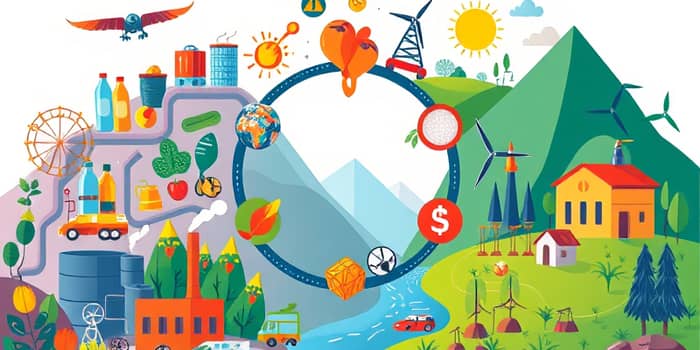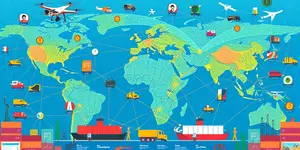
As pressure grows on planetary boundaries, the circular economy emerges as a visionary framework to reconceptualize how we produce, consume, and regenerate resources. By shifting from a linear “take-make-waste” model to one that prioritizes longevity, repair, and renewal, societies can unlock vast economic opportunities, bolster social equity, and restore environmental health.
Anchored in innovation and collaboration, the circular model challenges entrenched habits and invites stakeholders—from businesses and governments to communities and consumers—to participate in a transformative journey. This article explores the core principles, economic promise, pioneering examples, policy drivers, and the obstacles that lie ahead, offering practical insights for those ready to invest in waste reduction and reuse.
The circular economy is defined by its aim to keep products in use for as long as possible and to decouple economic growth from finite resource consumption. Rather than discarding materials after a single use, it deploys strategies such as maintenance, refurbishment, remanufacture, recycling, and composting to create a continuous loop of value.
By designing systems that eliminate waste at inception and regenerate natural capital, circularity addresses the root causes of resource depletion and environmental degradation. This contrasts sharply with today’s linear paradigm, which overshoots Earth’s regenerative capacity by a factor of 1.7 each year.
Transitioning to a circular economy offers a pathway to unlock up to $4.5 trillion in economic growth globally, driven by reduced material costs, new revenue streams, and greater supply chain resilience. In parallel, the model could create between six to eight million new jobs by 2030, with particular gains in manufacturing, recycling, and repair services.
Marginalized communities stand to benefit significantly through inclusion in circular value chains. For example, Kenya’s BlueBiz program engages waste pickers to collect and recycle plastic, processing up to two tons weekly per cooperative. This not only provides stable income but also fosters local agency in environmental stewardship.
Forward-thinking businesses are pioneering models that redefine ownership, usage, and end-of-life management. These innovations illustrate how circularity can be profitable and scalable:
Governments worldwide are implementing regulations to accelerate circular adoption. Extended Producer Responsibility (EPR) schemes require manufacturers to manage end-of-life product recovery. California’s Carpet Stewardship Program, for instance, boosted recycling rates from 20.9% in 2020 to 38% in 2024.
In the European Union, the Packaging and Packaging Waste Regulation (PPWR) mandates ecodesign, right-to-repair provisions, and ambitious reuse targets, aiming for a climate-neutral circular economy by 2050. Other nations, including France and Chile, have enacted laws to phase out single-use packaging in favor of refillable systems.
As raw material import costs surged—reaching a €29 billion trade deficit for the EU in 2023—policymakers recognize circularity as integral to resource security and economic sovereignty.
Global electronic waste is projected to hit 54–74 million metric tons annually by 2030, intensifying the need for advanced recovery solutions. Emerging technologies—such as AI-driven sorting, automated disassembly, and plasma arc recycling—are enhancing material recovery rates and reducing hazardous residues.
Investments in digital tracking and data analytics ensure that products can be traced through every lifecycle stage, improving the efficiency of take-back and remanufacturing programs. This convergence of technology and policy sets the stage for a robust circular ecosystem in the tech sector.
Product design is where over 80% of environmental impact is determined. Integrating circularity at the design phase—in the form of modularity, standardized components, and non-toxic materials—drives upstream waste reduction and simplifies end-of-life processing.
By prioritizing design strategies that minimize resource consumption and enable easy disassembly, companies can ensure that their offerings remain valuable assets rather than disposable liabilities.
Despite its promise, the circular transition faces significant hurdles: entrenched linear supply chains, upfront capital requirements, and the need for broad stakeholder alignment. Overcoming these barriers demands:
Financial instruments, such as green bonds and impact funds, can mobilize the billions needed to upgrade facilities and expand circular services worldwide.
Embracing the circular economy offers a powerful narrative: one where prosperity is generated not at the expense of ecological integrity, but in harmony with it. By investing in waste reduction, reuse, and regenerative practices, stakeholders can future-proof supply chains, foster social inclusion, and mitigate climate change.
Realizing this vision will require bold leadership, cross-sector collaboration, and unwavering commitment to systemic redesign. As businesses, policymakers, investors, and communities converge on this shared goal, they pave the way for a world where growth is regenerative, waste becomes a resource, and economic success goes hand in hand with planetary health.
References













